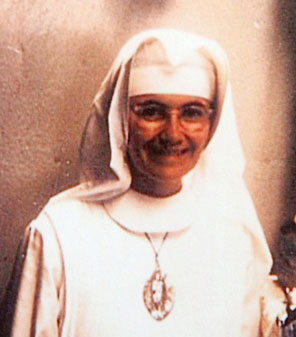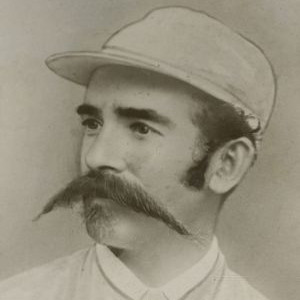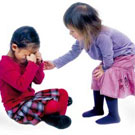Today is the Feast of St Andrew. It is also the anniversary of my Grandma’s sister.
On 30 November 1964, Connie Gladman — better known as Sr Mary Rosina, a Daughter of Our Lady of the Sacred Heart — was murdered in Papua New Guinea.
I have visited PNG twice, and on both occasions I have visited Aunty Connie’s grave and met with people who knew her. I was also able to piece together the remarkable story of her death.
Soon after 8:00, on the morning of 30 November 1964, Sr Rosina left her convent in Turuk and boarded a boat to Magien, a village on an island just off the coast of New Britain.
The Catholic mission of Turuk was only ten years old. The apostolic work was hard and discouraging. The local people were happy to benefit from the missionaries’ educational and medical services, but they were apparently indifferent to the Catholic faith. A week earlier, Sr Rosina had remarked on the mission’s slow progress.
“I would suffer anything,” she said, “to see the situation changed here.”
Sr Rosina was a trained teacher and a supervisor for the Department of Education. The primary school at Magien was staffed by indigenous teachers. It was her task to assess the teachers’ classroom performance and to conduct external examinations of the students.
Before Sr Rosina left the convent, she made some curious arrangements. She stripped her bed of its linen because, she said, she would sleep in the parlour that night. And she organised a substitute teacher for her afternoon classes on the mainland, even though she was due back in Turuk for lunch.
Sr Rosina’s behaviour on the voyage to the island was also unusual. She was normally gregarious, and made a point of drawing conversation out of the shy local girls who accompanied her. Today, however, Sr Rosina was silent, apparently preoccupied with prayer.
Sr Rosina arrived at the Magien school in time for morning assembly, after which she seated herself at the back of the classroom, pencil in hand. The children were at work, the teacher at a cupboard — his back turned to events — when a local man suddenly jumped through the window behind Sr Rosina. A child’s gasp caused the teacher to turn around and confront a horrifying scene. He watched helplessly as the intruder swung an axe into Sr Rosina’s neck three times, severing her spinal cord.
The children and their teacher ran from the classroom, screaming hysterically. “Rapui has killed Sister! Rapui has killed Sister!” Rapui was a local islander who had been detained for attempted murder and only recently discharged from psychiatric care. Rapui apparently nursed a grudge against the missionaries for his cousin’s death in a Catholic hospital.
Civil authorities on the mainland quickly learnt of events, and travelled to the island in the company of several OLSH sisters. Only after police had arrested Rapui, who was waiting at the jetty brandishing a knife, could the missionaries get to the school. There they found Sr Rosina seated at her desk, pencil still in hand. The force of the blows had caused her face to strike the desk before her.
That afternoon, Sr Rosina’s body was returned to the Turuk convent. Her odd behaviour that morning now seemed vindicated — she was not available to teach that afternoon, and her body was laid in the parlour overnight, where the sisters maintained an all-night prayer vigil.
A huge crowd of locals kept their own vigil, packing the mission’s lawns, crying and praying for Sr Rosina throughout the night. The slain missionary’s body was transported to the airport at dawn. A ute was found for the task, but the locals insisted on carrying the coffin themselves. A huge funeral procession, spontaneous and unprecedented, accompanied Sr Rosina’s departure from the Turuk mission.
Extraordinary graces unfolded in the years following. One of the girls who had accompanied Sr Rosina on her last voyage to Magien discerned a religious vocation, joining the OLSH convent. She was one of many who contributed to a 10 year boom in religious vocations.
Four years after the murder, the OLSH sisters, who were at that time predominantly Irish and Australian, withdrew from Turuk in favour of the indigenous Daughters of Mary Immaculate. This was made possible only by a sudden increase in faith among the locals, which occurred in the wake of Sr Rosina’s death. The rush of religious vocations eventually dried up, but the faith of the locals, and their remembrance of Sr Rosina, never waned.
Twenty years later, a schoolboy on Magien was deeply moved by the story. He was often found sitting at the place of Sr Mary Rosina’s death, and as the years progressed, he spent entire nights there. In secondary school, he discerned a priestly vocation, and in 2003, Fr John Bosco was ordained a priest. Fr John-Bosco attributed his vocation to the intercessory prayers of Sr Rosina, and on 30 November that year – the thirty-ninth anniversary of Sr Rosina’s death – the newly-ordained priest offered a Mass of Reconciliation at the site of the murder.
OLSH sisters were present at the mass, as were relatives of Rapui. Rapui himself had died earlier that year, still under psychiatric care, and always agitated by the sight of nuns in habit.
It is conjectured by some of the OLSH sisters whom I met that the Mass of Reconciliation lifted a curse which was uttered against the islanders of Magien by residents of Turuk, who sought pagan recourse in the immediate aftermath of Sr Rosina’s death. In any event, Magien has enjoyed a renaissance of priestly and religious vocations in the years since 2003. Graces continue to flow, it seems, from that tragic and blessed event of 1964.







This day one year ago I had the privilege of attending mass at Vunapope, PNG, in honour of my auntie, Sr MaryRose Gladman (Auntie Connie). My nephew Fr John Corrigan said mass in the chapel of the convent where Auntie Connie had once lived with the OLSH sisters. My husband David and I, along with my sister Carmel, who is the proud mother of Fr John, were privileged to accompany two of Auntie Connie’s sisters, my mother Muriel and my auntie, Barbara. Apart from Fr John, no other family member had ever visited Auntie Connie’s grave. It was a very emotional experience for which we were all very grateful. The OLSH sisters were wonderful.
Thankyou Fr John.
Has Sr Rosina’s cause been introduced, Fr John? Surely this holy woman gave her life for the conversion of souls.
I was very surprised, the first time I visited New Britain, to learn there is already a local cult of prayer surrounding her. And the popular opinion of the people who remember the story is that she was martyred.
An official declaration of martyrdom, however, can only follow something similar to the cause for beatification, and it’s not at all clear that the circumstances of her death meet the requirements.
Nonetheless, the Bishop of Rabaul is conscious of the case. I doubt the OLSH sisters are in a financial situation which allows for much to happen in the short term. But it’s something I’m praying for!
Please contact me… I just found the cut cut from my grandmother’s photo album and I’m trying to figure out if I’m related. I’m a decendant of Robert L Gladman 1854-1929
Hello great story does this make first Australia maytr people think Sr. Irene McCormack is first Austrlian Catholic to martyed overseas but this is not true! She was murded in May 1991.
Here is some more poetry from Mary Gilmore from The Rue Tree.
Lord when Thou lookest towards the earth,
Will Thou remember them,
Who, making Thee their only worth,
Touch life but by its hem…
Wilt Thou not turn Thine eyes where these
Follow where Thou didst tread,
Who, thought they drink life’s darkest lees,
Still bless for Thee, They bread?